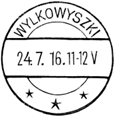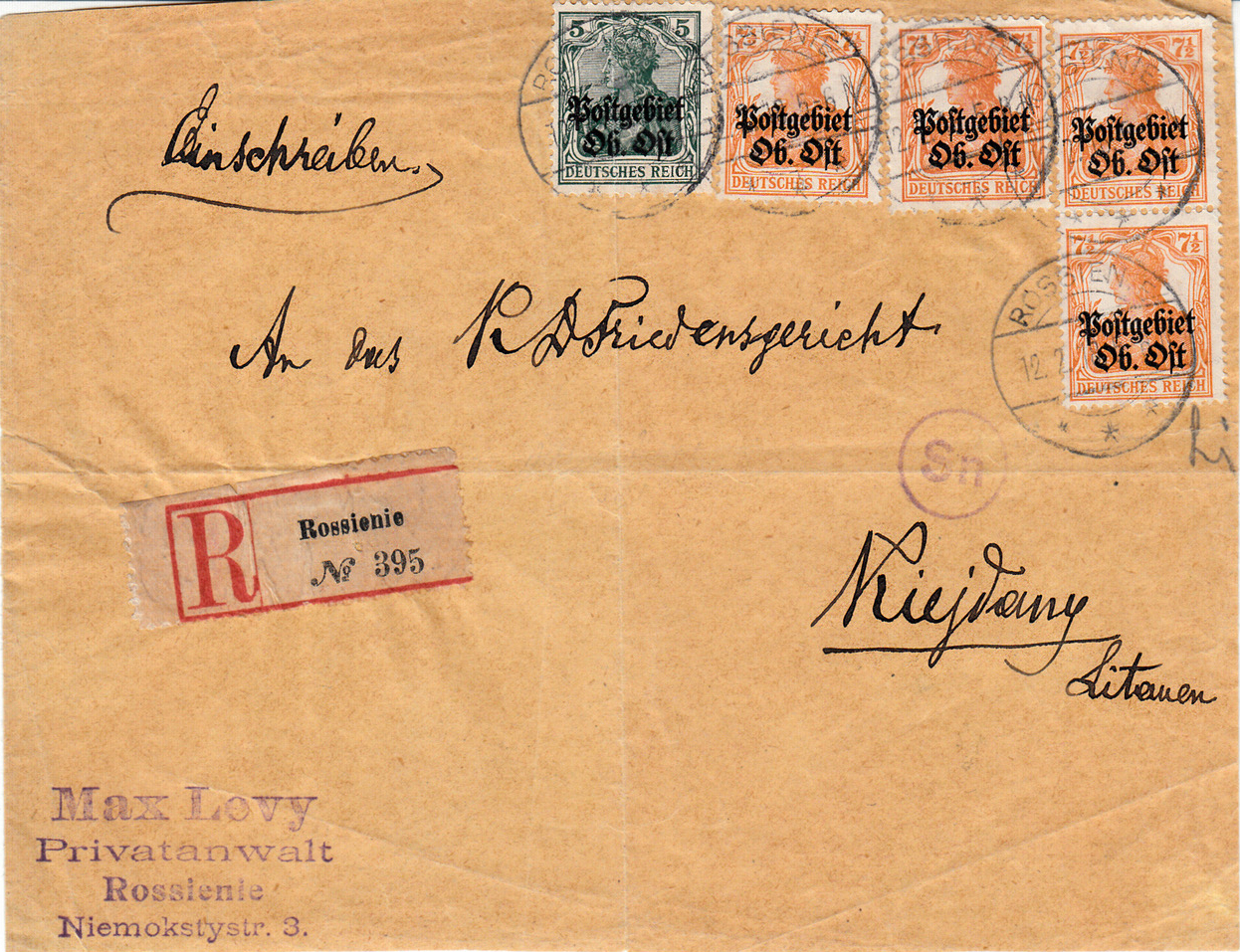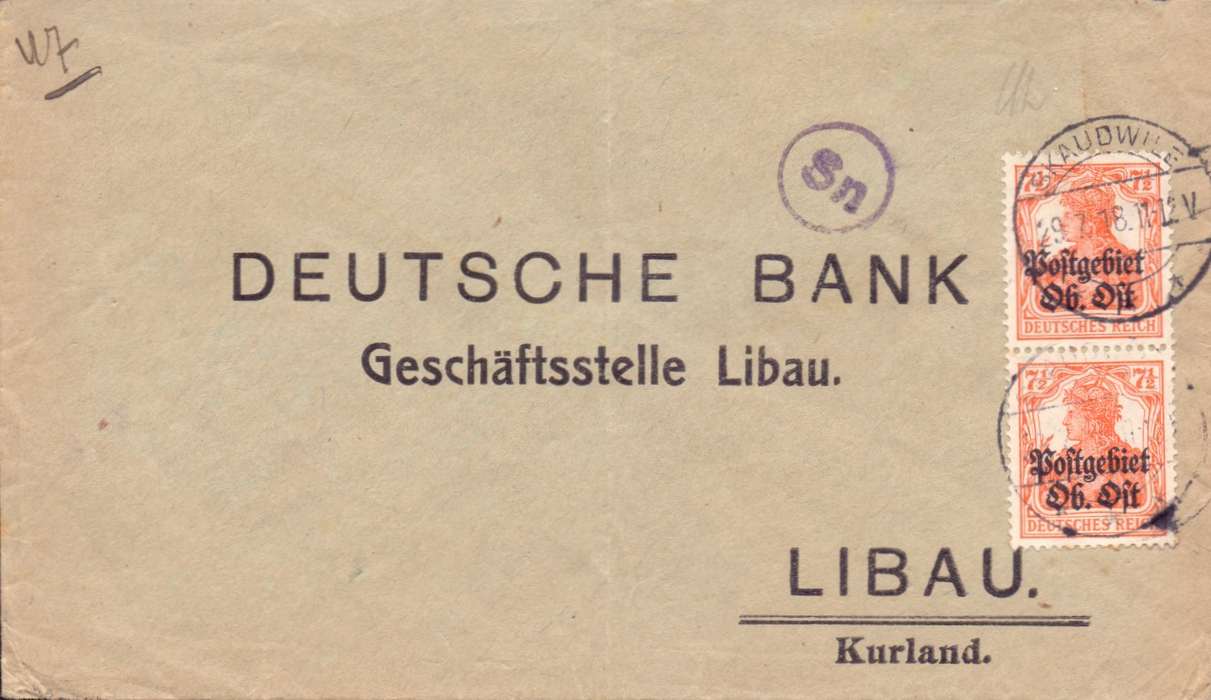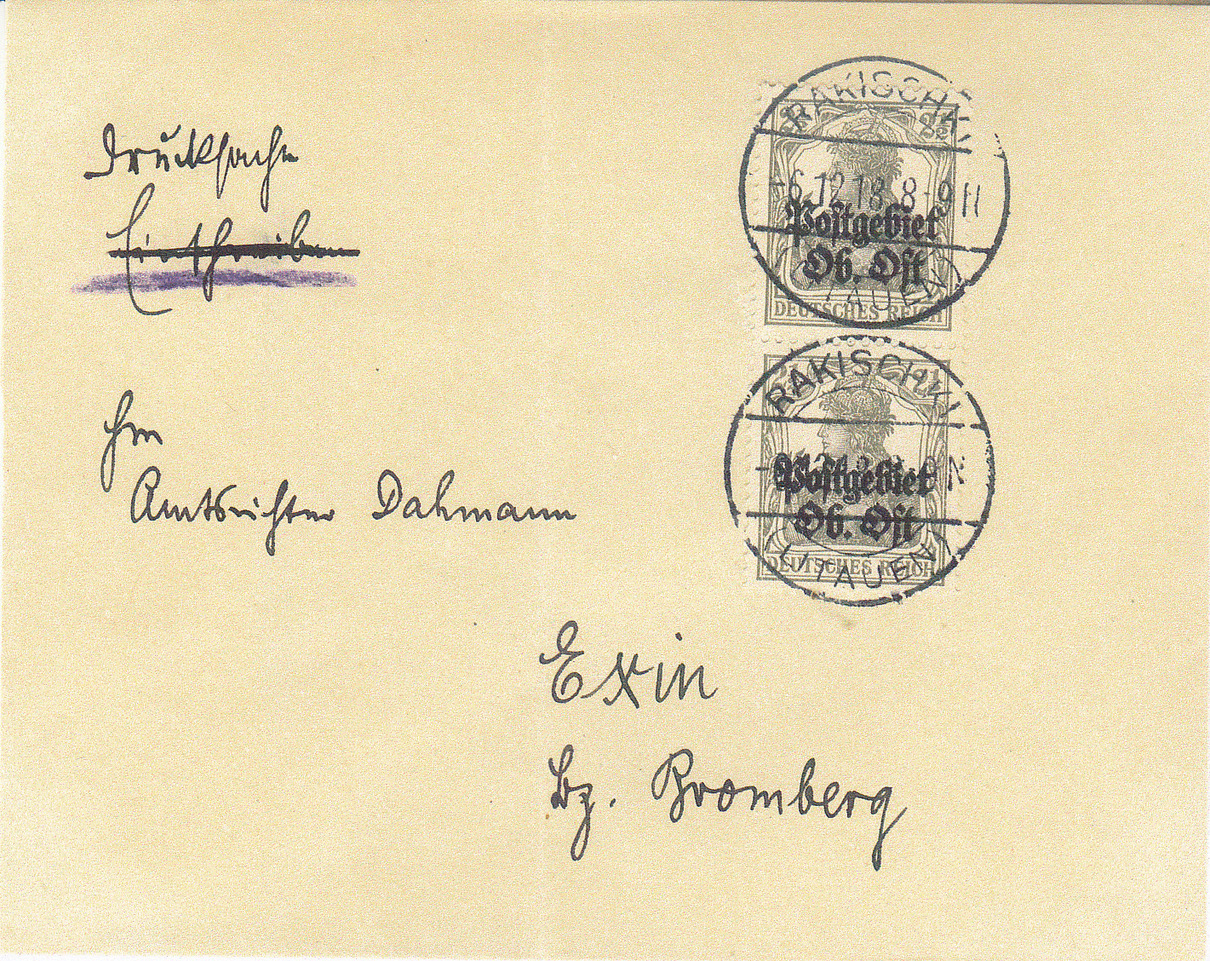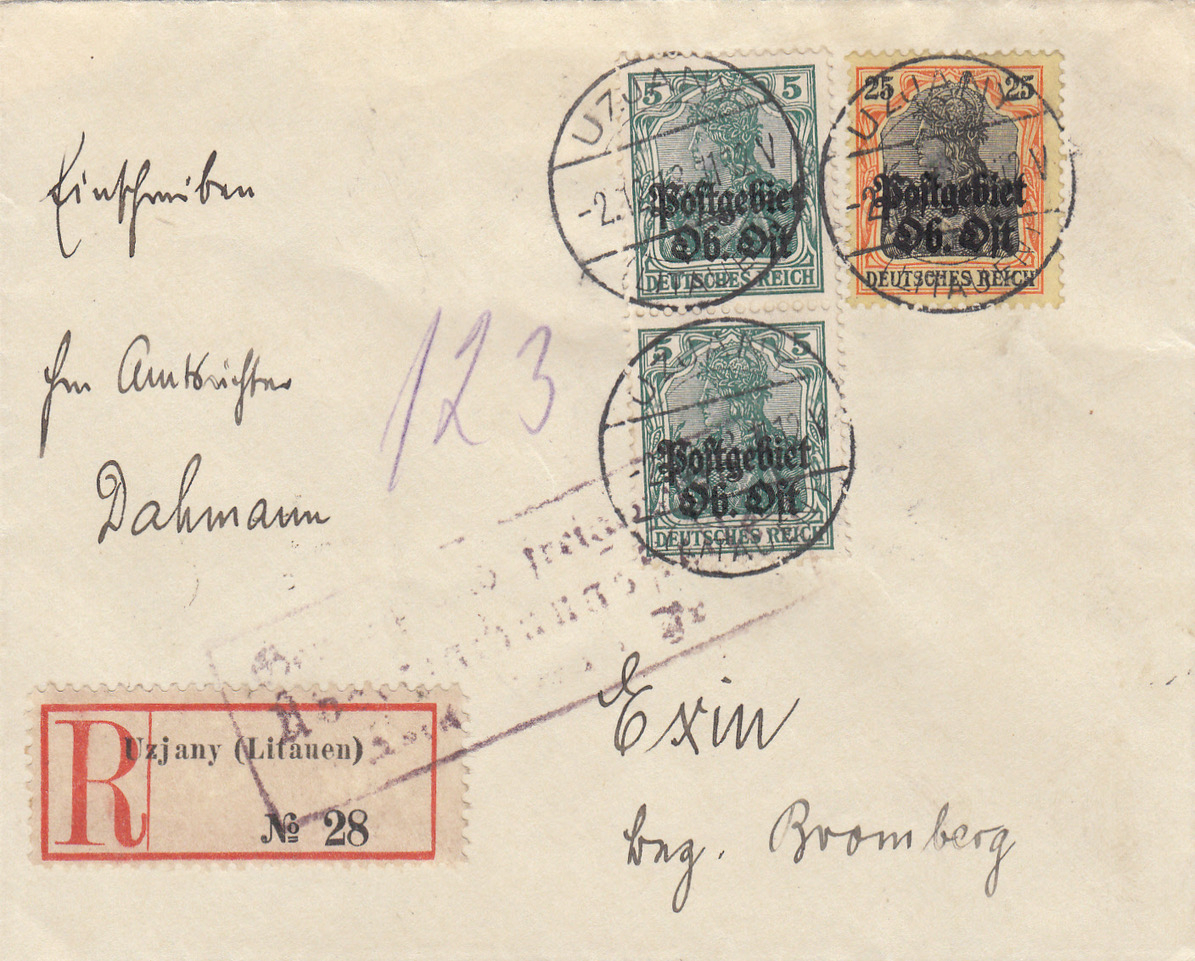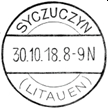Lithuania
-
Royal Polish Post
-
Imperial Russian Post
-
German Occupation / Ob. Ost
Before the beginning of the First World War, Lithuania in its current borders belonged predominantly to Russia and consisted of more or less large parts of the Tsarist governorates of Kaunas (Kowno), Vilnius (Wilna), Suwalki and a narrow strip in the north of the governorate of Hrodna (Grodno).
In addition to the 8th Army (Courland and northern Lithuania) and the 10th Army (around Vilnius, which was occupied on 18.9.1915 under General von Eichhorn), the Army Department Scholtz was also located in the area around Dünaburg (Daugapils) since 8.5.1915 with headquarters in Uzjany (Utena), where it also remained after being renamed Army Department D until 18.2.1918. In the south of Lithuania – more in what is now Belarusian territory – the 12th Army and later the Army Department Woyrsch secured the Russian Western Front.
The area that is now Lithuania was thus already largely occupied by German troops by the end of 1915 and had become part of the administrative territory of the Commander-in-Chief East of the German army.
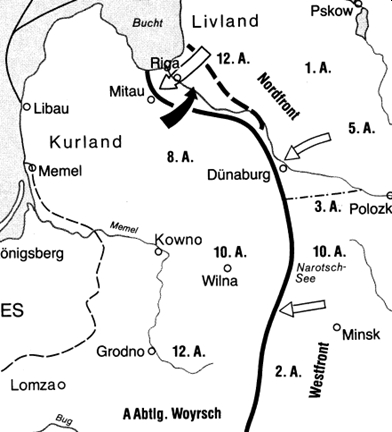
Map of the front line 2015 in Lithuania
Source: Piekalkiewicz, Janusz 1994: Der erste Weltkrieg (the First Wold War). Augsburg. p. 484.
The Russian Tsar Nicholas II abdicated on March 15, 1917, and the former Russian Minister of Justice Alexander Kerensky was appointed Minister of War. The Kerensky offensive in July 1917 on the Russian southwest front failed and delayed the Bolsheviks' efforts. to enter into armistice and peace negotiations with the Central Powers (German Empire, Austria-Hungary and other allies).
After the Russian October Revolution (25.10.1917 according to the Julian or 7.11.1917 according to the Gregorian calendar), the Taryba (the Lithuanian State Council) pushed for the restoration of the independent state of Lithuania. Lithuania's independence aspirations by the Taryba were signed in a founding act (Declaration of Independence) on 11 Dec. 1917 and 16 Feb. 1918 respectively (this is still Lithuania's bank holidays). However, this had no effect on the further opening of post offices in the Upper East area.
On 15.12.1917, an armistice was concluded between the Central Powers and the Soviet government with validity from 17.12.1917 (according to the Julian calendar 4.12.1917) at 2 pm. On 19.02.1918 – after failed peace negotiations with the Bolsheviks – the Supreme Army Command of the German Reich ordered the further advance. The German troops advanced very quickly to the north (Livonia and Estonia) and to the east (towards Minsk). This made it possible for the German occupation forces in the sparsely populated and lake-rich area in eastern Lithuania and north of Vilnius (Wilna) to open further provincial post offices in the area of the Supreme Commander East.
Postal area Upper East in the area of today's Lithuania
Note: the following place names are shown in Polish (German / Lithuanian) in areas with a predominantly Polish population, otherwise in German (Lithuanian).
The first national post offices in Lithuania were opened on January 15, 1916 in Kielmy (Kelm / Kelmė), Kowno (Kauen / Kaunas), Olita (Alitten / Alytus), Poniewiez (Ponewiesch / Panevežys), Schaulen (Šiauliai), Wilno (Vilna / Vilnius) and Wylkowyszki (Wilkowischken / Vilkaviškis).
The Kielmy post office (Kelm / Kelmė), which was also opened on 15.01.1916, is a special case. In Kielmy, the existing field post office No. 170 was responsible for the postal and telegram traffic of the civilian population. The date of closure is 19.10.1916; the field post office had been moved to Skaudwile (Skaudvile), according to the official gazette of the Reichs-Postamt in Berlin on 2.11.1916. Letters and postcards from this post office are rare.
The production of the German steel stamps for the Lithuanian postal towns was often very much based on the Polish spelling. This also stems from the majority Polish-inhabited areas around Vilnius.
The postmark of the postal town of Wylkowyszki was replaced in the same year (1916):

Commercial cover with envelope from the Wloclawek sulphite cellulose factory, Wloclawek, at that time Generalgouvernement Warsaw, with date stamp from Schaulen a of 6.1.18 to Vilnius. Censored by the Schaulen postal surveillance office (Sn). Delivered in Vilnius by the Vilnius Citizen's Post Office, which collected 10 Pf. order money for it.
Postal control centres on Lithuanian territory for postal traffic circulating within the postal area of Oberbefehlshaber Ost were located in Kowno, Schaulen and Wilna.
On April 20, 1916, three more post offices were opened in Kalwaria (Kalvarien / Kalvarija), Mariampol (Mariampol / Marijampolė) and Wladyslawowo (Wladislawow / Vladislavovas) to satisfy civilian postal traffic.
.On July 1, 1916 further post offices were established in Janow (Janovas), Raseinien (formerly Rossienie / Raseiniai), Krottingen (Kretinga) and Telsze (Telsche(n) / Telšiai).
In contrast to the governorates of Estonia, Livonia and Courland, there is only a very limited bank mail traffic on Lithuanian territory, mainly on mail from Kowno (Kaunas) and Vilnius.
There are also isolated bank vouchers from Mariampol (Mariampolė), Schaulen (Šiauliai) and Skaudwile (Skaudvile).Since the beginning of the year 1917, one finds numerous demand post to the Deutsche Bank with branch in Libau (Liepāja), today Latvia.
The letter from Skaudwile dated 29.07.1918 was first censored at the Schaulen (Sn) postal surveillance office before being forwarded to Libau.
With the German advance to the north and east from February 1918, further provincial post offices were opened.
Wilkomierz (Wilkomir / Ukmergė) received a field post office on 1.3.1918, which also handled the civilian postal traffic of the population, and Swenzjany (Švencionys) received a postal agency on 1.8.1918, which also handled postal traffic for the military authorities and units located in and around Swenzjany.
A postal agency was also opened in Georgenburg (Jurbarkas), just a few kilometres east of the border with the Kaliningrad oblast, on 10.9.1918.
Of the post towns opened on 11.11.1918, the cancellations shown here on the printed matter from Rakischki (Rokiskis), registered letter from Uzjany (Utena) and the letter piece and R label from Radziwilischki (Radviliškis) belong to the few existing "postal contemporary witnesses".
Due to completely insufficient documentary material, the actual opening of the post office is not guaranteed for all postal locations.
Even the philatelic experts of almost 100 years ago (Gundlach, Noske and Zirkenbach) did not agree on the existence of the Janischki, Kiejdany and Szczuczyn post offices in particular.
A special feature with the regional reference to Lithuania is the postmark of the town of Szczuczyn (Shchuchyn / ukynas) / Lithuania . (not to be confused with the present-day postal town of Sczuczyn in Poland).
The stamp impressions shown here are both from samples that were struck on white paper after the stamp production for control purposes.
It seems likely that the incorrectly designed postmark "Syczuczyn / (Lithuania)" (left) was used at first. The corrected postmark "Szczuczyn / (Lithuania)" (right) with a date after the closure of the Ober-Ost post offices is certainly only a proof (probably by Gleichmann printing shop, Berlin) – it has never been seen on mail before.
Real covers from Szczuczyn (and thus evidence of actual postmark use) are not yet available.
The cessation of postal operations in the Upper East postal area on Lithuanian territory took place successively between 9.12.1918 and finally in Kowno (Kaunas) on 31.12.1918. The postmaster there, Gundlach, remained in Kowno for accounting purposes until January 4, 1919.
Openings of post offices in the Upper East / Lithuania postal area
1916
15.01.1916
Kielmy (closed and transferred to Skaudwile on 19.10.1916)
Kowno
Olita
Poniewiez
Schaulen
Wilno
Wylkowyszki (from 2.10.1916 new postmark "Wilkowischki")
20.04.1916
Kalwaria
Mariampol
Władysławowo
01.07.1916
Janow
Raseinien
Telsze
20.10.1916
Skaudwile
1918
01.03.1918
Wilkomierz (Field post office with civilian mail handling)
01.08.1918
Swenzjany (Postal agency with military mail handling)
10.09.1918
Georgenburg
11.11.1918
Rakischki
Janischki (Opening disputed)
Kiejdany (Opening disputed)
Radziwilischki
Szczuczyn (Opening disputed)
Uzjany
NB.! Postal items from the provincial post offices opened in Lithuania in 1918 are among the rarities of the postal area "Commander-in-Chief East"!
Post office closures
9. to 31.12.1918 (Kaunas, accounting there until 4.1.1919)
-
Independent Republic of Lithuania
-
Central Lithuania
-
Memel Area / Klaipėda
-
Soviet Occupation
-
German Occupation / Ostland
-
Camp Mail / Lithuanians in Exile
-
Independent Republic of Lithuania (restored)
-
Private Mail in Lithuania



